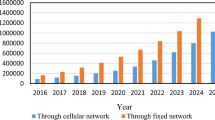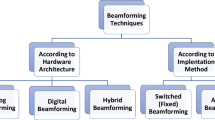Abstract
In this paper, we studied a comprehensive analytical symbol error probability (SEP) performance analysis of downlink multiuser diversity (MUD) on orthogonal space–time block code (OSTBC) system with transmit antenna selection (TAS) in the presence of imperfect channel state information (CSI) due to feedback delay over Rayleigh fading channels. The novel analytical approach is suitable for MUD with TAS/OSTBC systems in which effective receiver signal-to-noise ratio (SNR) is described as highest order statistic of Chi square distribution. Based on this framework, the closed-form SEP expressions are evaluated for the MUD exploiting TAS/OSTBC with normalized SNR based scheduling in heterogeneous wireless networks. Further, we derive approximate SEP; upper bound and lower bound SEP at high SNR under delayed feedback CSI. Thereafter the impact of feedback delay and antenna structures with significance on the consideration of MUD on the performance of the system has been analyzed.




Similar content being viewed by others
References
Ahn, K. S., Heath, R. W, Jr., & Baik, H. K. (2008). Shannon capacity and symbol error rate of space-time block codes in MIMO Rayleigh channels with channel estimation error. IEEE Transactions on Wireless Communications, 7(1), 324–333.
Bahceci, I., Duman, T. M., & Altunbasak, Y. (2003). Antenna selection for multiple-antenna transmission systems: Performance analysis and code construction. IEEE Transactions on Information Theory, 49, 2669–2681.
Bai, D., Mitran, P., Ghassemzadeh, S. S., Miller, R. R., & Tarokh, V. (2009). Rate of channel hardening of antenna selection diversity schemes and its implication on scheduling. IEEE Transactions on Information Theory, 55(10), 4353–4365.
Caire, G., & Shamai, S. (2003). On the achievable throughput of a multi-antenna Gaussian broadcast channel. IEEE Transactions on Information Theory, 49, 1691–1706.
Chalise, B. K., & Czylwik, A. (2008). Exact outage probability analysis for a multiuser MIMO wireless communication system with space-time block coding. IEEE Transactions on Vehicular Technology, 57(3), 1502–1512.
Chauhan, S. S., & Kumar, S. (2015). Adaptive-transmission channel capacity of maximal ratio combining with antenna selection in Nakagami-m fading channels. Springer Wireless Personal Communications, 85(4), 2233–2243.
Chauhan, S. S., & Kumar, S. (2015). Unified symbol error probability analysis of multiuser diversity in TAS/OSTBC systems. Springer Telecommunication Systems,. doi:10.1007/s11235-015-0097-3.
Cho, K., & Yoon, D. (2002). On the general BER expression of one-and two-dimensional amplitude modulations. IEEE Transactions on Communications, 50, 1074–1080.
David, H. A. (1970). Order statistics. New York: Wiley.
Gozali, R., Buehrer, R. M., & Woerner, B. D. (2003). The impact of multiuser diversity on space-time block coding. IEEE Communications Letters, 7(5), 213–215.
Gradshteyn, I. S., & Ryzhik, M. (2000). Table of integrals, series, and products (6th ed.). San Diego, CA: Academic.
Haccoun, D., Torabi, M., & Ajib, W. (2010). Performance analysis of multiuser diversity with antenna selection in MIMO MRC systems. Elsevier Physical Communications, 3, 276–286.
Jiang, J., Buehrer, R. M., & Tranter, W. H. (2004). Antenna diversity in multiuser data networks. IEEE Transactions on Communications, 52(3), 490–497.
Ko, Y., & Tepedelenlioglu, C. (2006). Orthogonal space-time block coded rate-adaptive modulation with outdated feedback. IEEE Transactions on Wireless Communications, 5(2), 290–295.
Lee, D., & Kim, K. (2009). Error probability analysis of combining space-time block coding and scheduling in MIMO systems. IEEE Signal Processing Letters, 16(12), 1071–1074.
Li, G., Blostein, S. D., & Feng, J. (2013). Performance analysis of OSTBC transmission in multiuser multiantenna relay networks. IEEE Transactions on Vehicular Technology, 62(1), 421–427.
Lopez, J., & Anton-Haro, C. (2006). Analytical assessment of multiuser vs spatial diversity trade-offs with delayed channel state information. IEEE Communications Letters, 10(8), 588–590.
Loskot, P., & Beaulieu, N. C. (2009). Prony and polynomial approximations for evaluation of the average probability of error over slow-fading channels. IEEE Transactions on Vehicular Technology, 58(3), 1269–1280.
Lu, J., Letaief, K. B., Chuang, J. C. I., et al. (1999). M-PSK and M-QAM BER computation using signal-space concepts. IEEE Transactions on Communications, 47(2), 181–184.
[Online] Available: http://functions.wolfram.com/.
Ramya, T. R., & Bhashyam, S. (2009). Using delayed feedback for antenna selection in MIMO systems. IEEE Trans on Wireless Communications, 8(12), 6059–6067.
Simon, M. K., & Alouini, M. S. (2000). Digital communication over fading channels: A unified approach to performance analysis. New York: John Wiley and Sons.
Torabi, M. (2008). Antenna selection for MIMO-OFDM systems. Elsevier Signal Processing, 88(10), 2431–2441.
Torabi, M., & Haccoun, D. (2011). Performance analysis of joint user scheduling and antenna selection over MIMO fading channels. IEEE Signal Processing Letters, 18(4), 235–238.
Yang, L., & Alouini, M.-S. (2006). Performance analysis of multiuser selection diversity. IEEE Transactions on Vehicular Technology, 55(3), 1003–1018.
Yu, W., & Cioffi, J. (2004). Sum capacity of Gaussian vector broadcast channels. IEEE Transactions on Information Theory, 50(9), 1875–1892.
Zhang, X., Lv, Z., & Wang, W. (2008). Performance analysis of multiuser diversity in MIMO systems with antenna selection. IEEE Transactions on Wireless Communications, 7(1), 15–20.
Author information
Authors and Affiliations
Corresponding author
Appendix
Appendix
Inserting (16) and (25) into (18)
Utilizing the identity [11] \(\mathop \int \limits_{0}^{\infty } x^{v - 1} e^{ - \mu x} dx = \frac{1}{{\mu^{v} }}\varGamma \left( v \right)\), we can achieve approximate closed-form expression of average SEP of MUD-MIMO with TAS/MRC using MPSK in (26).
Rights and permissions
About this article
Cite this article
Chauhan, S.S., Kumar, S. Performance Analysis of Multiuser Diversity on OSTBC MIMO Systems with Antenna Selection in the Presence of Feedback Delay CSI. Wireless Pers Commun 92, 695–710 (2017). https://doi.org/10.1007/s11277-016-3572-6
Published:
Issue Date:
DOI: https://doi.org/10.1007/s11277-016-3572-6




